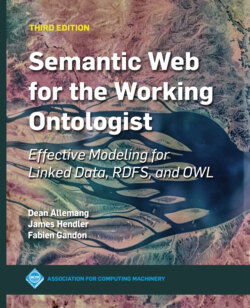| | Contents |
| | Preface |
| Chapter 1 | What Is the Semantic Web? |
| | 1.1 What Is a Web? |
| | 1.2 Communicating with Data |
| | 1.3 Distributed Data |
| | 1.4 Summary |
| Chapter 2 | Semantic Modeling |
| | 2.1 Modeling for Human Communication |
| | 2.2 Explanation and Prediction |
| | 2.3 Mediating Variability |
| | 2.4 Expressivity in Modeling |
| | 2.5 Summary |
| Chapter 3 | RDF—The Basis of the Semantic Web |
| | 3.1 Distributing Data Across the Web |
| | 3.2 Merging Data from Multiple Sources |
| | 3.3 Namespaces, URIs, and Identity |
| | 3.4 Identifiers in the RDF Namespace |
| | 3.5 CHALLENGES: RDF and Tabular Data |
| | 3.6 Higher-Order Relationships |
| | 3.7 Naming RDF Graphs |
| | 3.8 Alternatives for Serialization |
| | 3.9 Blank Nodes |
| | 3.10 Summary |
| Chapter 4 | Semantic Web Application Architecture |
| | 4.1 RDF Parser/Serializer |
| | 4.2 RDF Store |
| | 4.3 Application Code |
| | 4.4 Data Federation |
| | 4.5 Summary |
| Chapter 5 | Linked Data |
| | 5.1 Weaving a Web of Data |
| | 5.2 HTTP and the Architecture of the Web |
| | 5.3 Hash or Slash |
| | 5.4 See It for Yourself… |
| | 5.5 Summary |
| Chapter 6 | Querying the Semantic Web—SPARQL |
| | 6.1 Tell-and-Ask Systems |
| | 6.2 RDF as a Tell-and-Ask System |
| | 6.3 SPARQL—Query Language for RDF |
| | 6.4 CONSTRUCT Queries in SPARQL |
| | 6.5 Using Results of CONSTRUCT Queries |
| | 6.6 SPARQL Rules—Using SPARQL as a Rule Language |
| | 6.7 Transitive queries (SPARQL 1.1) |
| | 6.8 Advanced Features of SPARQL |
| | 6.9 Summary |
| Chapter 7 | Extending RDF: RDFS and SCHACL |
| | 7.1 Inference in RDF with RDFS |
| | 7.2 Where are the Smarts? |
| | 7.3 When Does Inferencing Happen? |
| | 7.4 Expectation in RDF |
| | 7.5 Summary |
| Chapter 8 | RDF Schema |
| | 8.1 Schema Languages and Their Functions |
| | 8.2 The RDF Schema Language |
| | 8.3 RDFS Modeling Combinations and Patterns |
| | 8.4 Challenges |
| | 8.5 Modeling with Domains and Ranges |
| | 8.6 Nonmodeling Properties in RDFS |
| | 8.7 Summary |
| Chapter 9 | RDFS-Plus |
| | 9.1 Inverse |
| | 9.2 Managing Networks of Dependencies |
| | 9.3 Equivalence |
| | 9.4 Merging Data from Different Databases |
| | 9.5 Computing Sameness: Functional Properties |
| | 9.6 A Few More Constructs |
| | 9.7 Summary |
| Chapter 10 | Using RDFS-Plus in the Wild |
| | 10.1 Schema.org |
| | 10.2 Open Government Data |
| | 10.3 FOAF |
| | 10.4 Facebook’s Open Graph Protocol |
| | 10.5 Summary |
| Chapter 11 | SKOS—Managing Vocabularies with RDFS-Plus |
| | 11.1 Simple Knowledge Organization System (SKOS) |
| | 11.2 Semantic Relations in SKOS |
| | 11.3 Concept Schemes |
| | 11.4 SKOS Integrity |
| | 11.5 SKOS in Action |
| | 11.6 Summary |
| Chapter 12 | Basic OWL |
| | 12.1 Restrictions |
| | 12.2 Challenge Problems |
| | 12.3 Alternative Descriptions of Restrictions |
| | 12.4 Summary |
| Chapter 13 | Counting and Sets in OWL |
| | 13.1 Unions and Intersections |
| | 13.2 Differentiating Multiple Individuals |
| | 13.3 Cardinality |
| | 13.4 Set Complement |
| | 13.5 Disjoint Sets |
| | 13.6 Prerequisites Revisited |
| | 13.7 Contradictions |
| | 13.8 Unsatisfiable Classes |
| | 13.9 Inferring Class Relationships |
| | 13.10 Reasoning with Individuals and with Classes |
| | 13.11 Summary |
| Chapter 14 | Ontologies on the Web—Putting It All Together |
| | 14.1 Ontology Architecture |
| | 14.2 Quantities, Units, Dimensions, and Types |
| | 14.3 Biological Ontologies |
| | 14.4 FIBO—The Financial Industry Business Ontology |
| | 14.5 Summary |
| Chapter 15 | Good and Bad Modeling Practices |
| | 15.1 Getting Started |
| | 15.2 Good Naming Practices |
| | 15.3 Common Modeling Errors |
| | 15.4 Summary |
| Chapter 16 | Expert Modeling in OWL |
| | 16.1 OWL Subsets and Modeling Philosophy |
| | 16.2 OWL 2 Modeling Capabilities |
| | 16.3 Summary |
| Chapter 17 | Conclusions and Future Work |
| | Bibliography |
| | Authors’ Biographies |
| | Index |
